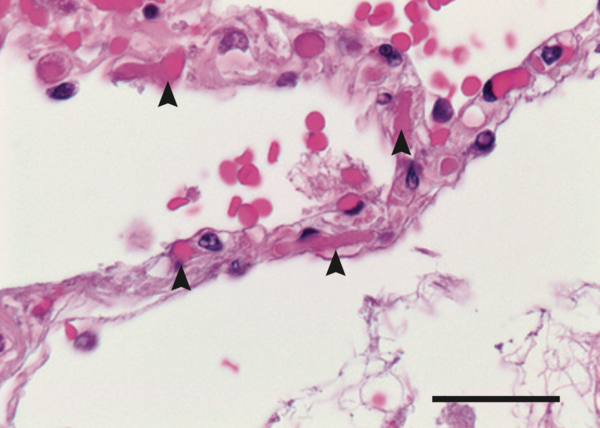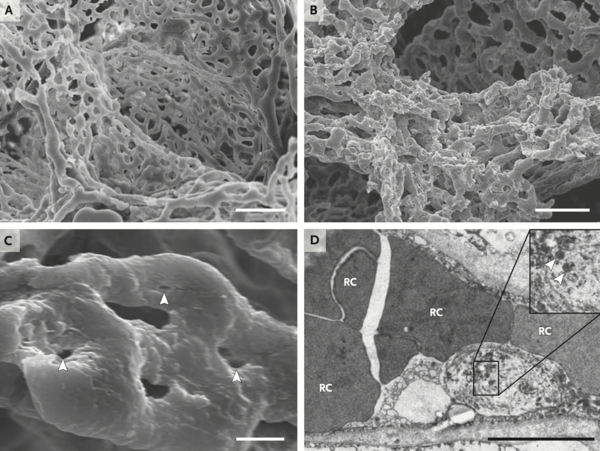BACKGROUND:
Progressive respiratory failure is the primary cause of death in the coronavirus disease 2019 (Covid-19) pandemic. Despite widespread interest in the pathophysiology of the disease, relatively little is known about the associated morphologic and molecular changes in the peripheral lung of patients who die from Covid-19.
METHODS:
We examined 7 lungs obtained during autopsy from patients who died from Covid-19 and compared them with 7 lungs obtained during autopsy from patients who died from acute respiratory distress syndrome (ARDS) secondary to influenza A(H1N1) infection and 10 age-matched, uninfected control lungs. The lungs were studied with the use of seven-color immunohistochemical analysis, micro-computed tomographic imaging, scanning electron microscopy, corrosion casting, and direct multiplexed measurement of gene expression.
RESULTS:
In patients who died from Covid-19-associated or influenza-associated respiratory failure, the histologic pattern in the peripheral lung was diffuse alveolar damage with perivascular T-cell infiltration. The lungs from patients with Covid-19 also showed distinctive vascular features, consisting of severe endothelial injury associated with the presence of intracellular virus and disrupted cell membranes. Histologic analysis of pulmonary vessels in patients with Covid-19 showed widespread thrombosis with microangiopathy. Alveolar capillary microthrombi were 9 times as prevalent in patients with Covid-19 as in patients with influenza (P<0.001). In lungs from patients with Covid-19, the amount of new vessel growth -- predominantly through a mechanism of intussusceptive angiogenesis -- was 2.7 times as high as that in the lungs from patients with influenza (P<0.001).
CONCLUSIONS:
In our small series, vascular angiogenesis distinguished the pulmonary pathobiology of Covid-19 from that of equally severe influenza virus infection. The universality and clinical implications of our observations require further research to define.
Covid-19における肺血管内皮炎、血栓症、血管新生(N Engl J Med.2020.05.21)
背景
進行性の呼吸不全は、コロナウイルス感染症2019(Covid-19)パンデミックの主要な死因である。本疾患の病態生理に広く関心が寄せられているにもかかわらず、Covid-19の死亡症例の末梢肺の形態学的/分子学的変化は、未解明である。
方法
Covid-19で死亡し、剖検を行った患者の7つの肺を調べ、インフルエンザA(H1N1)急性呼吸窮迫症候群(ARDS)で死亡し、剖検を行った患者の7つの肺と、年齢をマッチさせた10の非感染肺とを比較した。肺に対して、7色の免疫組織化学的分析、マイクロコンピュータ断層撮影、走査型電子顕微鏡、腐蝕解剖学鋳型、direct multiplexの遺伝子発現測定を行なった。
結果
Covid-19とインフルエンザ呼吸不全の死亡患者の両者で、末梢肺の組織学的パターンは、血管周囲T細胞浸潤を伴うびまん性肺胞損傷であった。Covid-19の患者からの肺には、重度の内皮損傷の特徴があり、細胞内にはウイルスが存在し、細胞膜破壊を伴っていた。Covid-19患者の肺血管の組織学的解析では、微小血管症を伴う広範な血栓症が認められた。Covid-19患者ではインフルエンザ患者に比し、9倍多く肺胞毛細血管の微小血栓症を認めた(P<0.001)。Covid-19の肺では、インフルエンザの肺に比して、血管新生量は2.7倍多く、主に管腔内分裂型のメカニズムを介していた(P<0.001)。
結論
この少数例の検討では、血管新生という点で、Covid-19の肺の病態は重症インフルエンザウイルス感染症と異なっている。本結果の普遍性と臨床的意義の解明にはさらなる研究が必要である。


(千葉大学大学院医学研究院 救急集中治療医学 中田孝明コメント)
Covid-19重症患者で見られる呼吸不全の病態に関する論文。肺血管内皮障害、微小血栓、血管新生が特徴であることが示されている。新規治療法の開発の礎となる、死因と関連する病態解明が進んでいる。